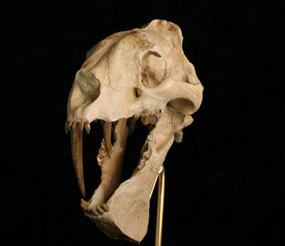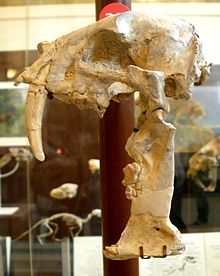Eusmilus
| Eusmilus | ||||||||||||
|---|---|---|---|---|---|---|---|---|---|---|---|---|

Skull of Eusmilus cerebralis |
||||||||||||
| Temporal occurrence | ||||||||||||
| late Eocene to early Oligocene | ||||||||||||
| 38 to 28.1 million years | ||||||||||||
| Locations | ||||||||||||
|
||||||||||||
| Systematics | ||||||||||||
|
||||||||||||
| Scientific name | ||||||||||||
| Eusmilus | ||||||||||||
| Gervais , 1876 | ||||||||||||

Eusmilus ( Greek εὖ eu 'good, true' and σμίλη smílē 'chisel') is a genus of extinct feline predators . It belongs to the family Nimravidae , which isknown exclusively from fossil sources . Eusmilus lived from the Priabonian (late Eocene ) to the Rupelian (early Oligocene ) in North America , Europe and Asia .
The genus was named in 1876 by the French paleontologist Paul Gervais . He built it for fossils from the phosphate mines of the Quercy , which had originally been assigned to the genus Machairodus .
morphology
Eusmilus had a long, elongated body and was about the size of a leopard, but shorter at the shoulder. It is also referred to as the false saber tooth , referring to Smilodon from the relatives of the saber-toothed cats within the Felidae family , which, however, only lived much later. But Eusmilus had truly gigantic canine teeth that were almost as long as his entire skull. Similar tooth formations emerged several times independently of one another in the course of evolution and are not an indication of close relationship, but of convergent developments. His jaw was rather weak, because he didn't need it because of his large canine teeth to fatally injure a prey. In contrast to most predatory mammals, Eusmilus only had 26 instead of 44 teeth. He was able to open his mouth 90 degrees so that he could use his saber teeth properly in battle. Injuries from these teeth have even been detected on a skull of Nimravus , a smaller member of the Nimravidae. Eusmilus hardly thought his relative was a prey, but probably wanted to drive him away as a food competitor. The body mass of Eusmilus is estimated at around 70 kilograms. On average, Eusmilus was 2.50 meters long including tail.
Systematics
Within the cat relatives, Eusmilus is placed in the family Nimravidae. However, the exact delimitation of the genera within this family is controversial.
Subfamily Hoplophoneinae
Particularly between the genera Hoplophoneus and Eusmilus there are always problems of assignment. Hoplophoneus and Eusmilus occurred both in the same period and in largely the same area of distribution. Some authors therefore summarize Hoplophoneus and Eusmilus in a common subfamily Hoplophoneinae within the family Nimravidae.
The most important distinguishing features between the two genera are the size of the two saber teeth of the upper jaw and the formation of the flange on the lower jaw, which provided a guide for the two canine teeth, which reached far over the lower jaw and protected them from breaking off. These teeth are more pronounced in Eusmilus , but this is not a clear generic feature.
species
According to the more recent view, Eusmilus comprises 5 species:
- Eusmilus bidentatus is the type species of the genus. The relevant finds come from the phosphate mines of the Quercy and the Lot département in southwest France and were described by Henri Filhol in 1872 under the name Machairodus bidentatus . The generic name Eusmilus was coined by Paul Gervais in 1876, after he had recognized that the pieces described by Filhol and the fossils from the same sites previously described as " Machairodus perarmatus " differ significantly from Machairodus . While the species Eusmilus perarmatus was subsequently considered identical to E. bidentatus , Gervais' genus has retained its validity to this day. E. bidentatus is the only European species. It has been identified not only in France, but also in localities in Germany and Switzerland.
- Eusmilus cerebralis is, like all following species, a North American form. It is smaller than the type species and was first described by Cope in 1880 under the name " Machærodus cerebralis " based on fossils from Oregon .
- Eusmilus dakotensis was first described by John Bell Hatcher in 1895 on the basis of a right lower jaw from the Brule Formation (White River Group) of Shannon County, South Dakota . This species is larger than Eusmilus bidentatus .
- Eusmilus sicarius was described by Sinclair and Jepsen in 1927 using a skull from the Brule Formation of Pennington County, South Dakota .
- Eusmilus olsontau was described as " Ekgmoiteptecela olsontau " by James Reid Macdonald in 1963 on the basis of a right lower jaw from the Sharps Formation of Shannon County, South Dakota. In this work the author assigns a Miocene age to the found layers . In the meantime, absolute dating of volcanic ash layers in the Sharps Formation indicates an age between the late Rupelian and early Chattian. E. olsontau is still one of the geologically youngest Eusmilus species. Some authors have synonymous E. olsontau with E. cerebralis .
E. dakotensis and E. sicarius are classified by some authors as belonging to the genus Hoplophoneus . Only relatively poorly preserved bones are known from Asia (China), which cannot be determined at the species level and which cannot be assigned with complete certainty to the genus Eusmilus .
Individual evidence
- ↑ Manuel J. Salesa, Mauricio Antón, Alan Turner, Jorge Morales: Aspects of the functional morphology in the cranial and cervical skeleton of the saber-toothed cat Paramachairodus ogygia (Kaup, 1832) (Felidae, Machairodontinae) from the Late Miocene of Spain : implications for the origins of the machairodont killing bite. Zoological Journal of the Linnean Society. Vol. 144, No. 3, 2005, pp. 363-377, doi : 10.1111 / j.1096-3642.2005.00174.x .
- ^ Larry D. Martin: Functional morphology and the evolution of cats. Transactions of the Nebraska Academy of Sciences. Vol. 8, 1980, pp. 141-153 ( online ), p. 145.
- ↑ Eusmilus at Prehistoric Wildlife, accessed on February 12, 2015 (English).
- ^ A b Mauricio Antón: Sabertooth. Indiana University Press, Bloomington (IN) 2013, ISBN 978-0-253-01042-1 , pp. 96 ff.
- ^ Henri Filhol: Note relative a la découverte dans le gisements de phosphate de chaux du Lot d'un mammifère fossile nouveau. Bulletin de la Société des sciences physiques & naturelles de Toulouse. Vol. 1, 1872, pp. 205-208 ( HathiTrust ).
- ↑ a b Stéphane Peigné, Michel Brunet: Une nouvelle espèce du genre Eusmilus (Carnivora: Nimravidae) de l'Oligocène (MP 22) d'Europe. Geobios. Vol. 34, No. 6, 2001, pp. 657-672, doi : 10.1016 / S0016-6995 (01) 80027-9 (alternative full text access : ResearchGate ).
- ↑ Edward Drinker Cope: Notes on saber-tooths. The American Naturalist. Vol. 14, 1880, pp. 142-143 ( BHL ).
- ↑ Eusmilus dakotensis Hatcher, 1895. Online data sheet for the type specimen of this species in the Yale Peabody Museum, accessed on December 21, 2015 (English).
- ^ John Bell Hatcher: Discovery, in the Oligocene of South Dakota, of Eusmilus , a Genus of Saber-toothed Cats New to North America. The American Naturalist. Vol. 29, No. 2 1895, pp. 1091-1093 ( BHL ).
- ^ William J. Sinclair, GL Jepsen: The Skull of Eusmilus. Proceedings of the American Philosophical Society. Vol. 66, 1927, pp. 391-407 ( JSTOR 3301075 ).
- ↑ James Reid Macdonald: The Miocene faunas from the Wounded Knee area of western South Dakota. Bulletin of the American Museum of Natural History. Vol. 125, 1963, pp. 139-238 ( online ), pp. 220 ff.
- ↑ Thomas H. McConnell, Joseph N. DiBenedetto: Geology of the Early Arikareean Sharps Formation on the Pine Ridge Indian Reservation and Surrounding Areas of South Dakota and Nebraska. PLoS ONE. Vol. 7, No. 10, 2012, e47759, doi : 10.1371 / journal.pone.0047759 .
- ^ HN Bryant: Nimravidae. Pp. 453-475 in: Donald R. Prothero, Robert J. Emry (Eds.): The Terrestrial Eocene-Oligocene Transition in North America. Cambridge University Press, 1996, ISBN 978-0-521-43387-7 , p. 466.
- ↑ Larry D. Martin: Nimravidae. Pp. 228-235 in: Christine M. Janis, Kathleen M. Scott, Louis L. Jacobs (Eds.): Evolution of Tertiary Mammals of North America. Volume 1: Terrestrial Carnivores, Ungulates and Ungulatelike Mammals. Cambridge University Press, 1998, ISBN 978-0-521-35519-3 , p. 231.
- ↑ Stéphane Peigné, Yaowalak Chaimanee, Jean-Jacques Jaeger, Varavudh Suteethorn, Stéphane Ducrocq: Eocene nimravid carnivorans from Thailand. Journal of Vertebrate Paleontology. Vol. 20, No. 1, 2000, pp. 157-163, doi : 10.1671 / 0272-4634 (2000) 020 [0157: ENCFT] 2.0.CO; 2 (alternative full text access : ResearchGate ).
literature
- Mauricio Antón: Sabertooth . Indiana University Press, Bloomington (IN) 2013, ISBN 978-0-253-01042-1 .
- James Reid Macdonald: The Miocene faunas from the Wounded Knee area of western South Dakota. Bulletin of the American Museum of Natural History. Vol. 125, 1963, pp. 139-238 ( online ), pp. 220 f.
- Larry D. Martin: Functional morphology and the evolution of cats. Transactions of the Nebraska Academy of Sciences. Vol. 8, 1980, pp. 141-153 ( online ).
Web links
- Eusmilus. Profile on about.com, accessed on February 12, 2015 (English)
- Eusmilus. Profile on Prehistoric Wildlife.com, accessed on February 12, 2015 (English)
- Eusmilus cerebralis head restoration. Head reconstruction of Eusmilus cerebral on Deviant Art.com, accessed on 21 December 2015 (English)
